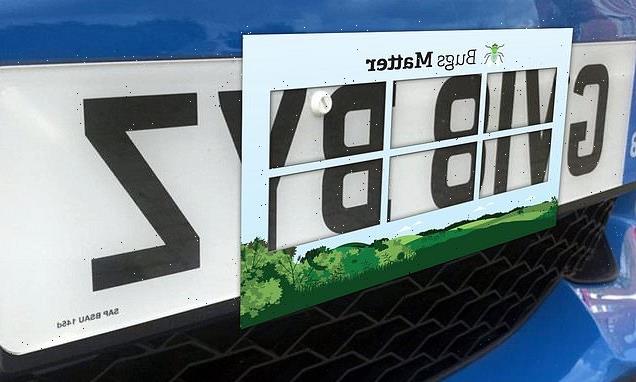
Drivers are urged to download a mobile app that can track insect populations by counting ‘splats’ on number plates
- New app aimed at tracking insect populations by counting number plate splats
- Drivers are being urged to download it and will then be shown how they can help
- They clean number plate, make journey and count bugs using ‘splatometer’ grid
- Hope is that scientists can use the data to estimate insect decline across Britain
Motorists are being encouraged to download a new app aimed at tracking the UK’s insect population by counting ‘bug splats’ on car number plates.
The hope is that the data will allow scientists to estimate insect decline across Britain.
Insect populations around the world are in flux, with land-based bugs seeing a dramatic decline over the past 30 years.
However, little is known about the state of insect populations in the UK because only butterflies and moths have been monitored in enough detail to allow trends to be fully understood.
Scroll down for video
‘Splatometer’ counter: Motorists are being encouraged to download a new app called Bugs Matter, aimed at tracking the UK’s insect population by counting ‘bug splats’ on number plates
Drivers will be given instructions on what to do when they download the Bugs Matter app, with the survey running from June 1 to August 31.
They should first clean their number plate, then complete their journey, and on arrival count the bugs squashed on it using a ‘splatometer’ grid which will be sent in the post when they sign up.
A photo and details should then be submitted via the app. The hope is that motorists will count the number of bugs squashed on as many journeys as possible during the timeframe of the survey.
The citizen science project is being run by Wildlife Trusts in Kent, Essex, Gwent and Somerset, alongside the charity Buglife.
Organisers say the survey is based on the ‘windscreen phenomenon’, a term given to the observation that people tend to find fewer insects squashed on the windscreens of their cars compared to several decades ago.
Drivers will be given instructions on what to do when they download the Bugs Matter app
‘Many people remark on not having to clean bug splats off their car windscreens as much as they did 20 or 30 years ago,’ said Andrew Whitehouse, countries manager for Buglife.
‘The falling abundance of flying insects should be a major concern to everybody as these essential creatures are, quite simply, the small things that run the world.’
Dr Paul Tinsley Marshall, from Kent Wildlife Trust, said: ‘Finding fewer squashed bugs on car number plates is concerning because it suggests their populations may be in trouble.
‘The main causes of their decline are chemical use across our countryside, road verges and gardens, and habitat loss – but we need lots more data to determine trends and people to take the survey during their day to day car travel.’
More information about the Bugs Matter app and details of how to download it can be found here.
Researchers claim the Earth is going through a ‘man made’ sixth mass extinction with the ‘biological annihilation’ of wildlife
The world has experienced five mass extinctions over the course of its history, and experts claim we are seeing another one happen right now.
A 2017 research paper claimed a ‘biological annihilation’ of wildlife in recent decades has triggered the sixth mass extinction and says the planet is heading towards a ‘global crisis’.
Scientists warn humanity’s voracious consumption and wanton destruction is to blame for the event, which is the first major extinction since the dinosaurs.
Two species of vertebrate, animals with a backbone, have gone extinct every year, on average, for the past century.
Currently around 41 per cent of amphibian species and more than a quarter of mammals are threatened with extinction.
There are an estimated 8.7 million plant and animal species on our planet and about 86 per cent of land species and 91 per cent of sea species remain undiscovered.
Of the ones we do know, 1,204 mammal, 1,469 bird, 1,215 reptile, 2,100 amphibian, and 2,386 fish species are considered threatened.
Also threatened are 1,414 insect, 2,187 mollusc, 732 crustacean, 237 coral, 12,505 plant, 33 mushroom, and six brown algae species.
More than 25,000 species of 91,523 assessed for the 2017 ‘Red List’ update were classified as ‘threatened’.
The number of invertebrates at risk has also peaked.
Scientists predict insects may go extinct within 100 years as a result of crippling population decline.
The dawn of the mass extinction coincides with the onset of the Anthropocene – the geological age defined by human activity being the dominant influence on climate and the environment.
Source: Read Full Article

